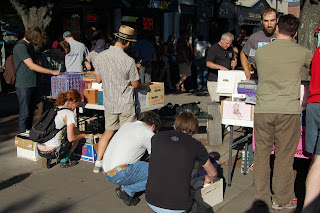Somerville, Mass - These days, Moscow nightlife is much about being elite. The trendiest spots are guarded by bouncers who take their job a little too seriously. The use "face control" to keep out potential patrons who won't enhance the atmosphere at their establishment by looking fabulous and spending money. And they really do call it "face control".
 But it's about so much more than your face. It's a quick and devastating head-to-toe examination to determine if you are the kind of person that they want.
But it's about so much more than your face. It's a quick and devastating head-to-toe examination to determine if you are the kind of person that they want.
It's based largely on what you are wearing (but notice they don't call it a dress code - it's way too arbitrary for that). Stepping out in Moscow requires dressing up, especially for women. Short skirts and tall heels are an absolute must. But it's not only that women have to wear short skirts and tall heels - they also have to look good in them.
My friend Tommo told me a story about an expat friend - let's call him "Matt" - who organized a private party at a Moscow club. When Matt showed up at the club with two slightly overweight female friends, who happened to be from Australia, the bouncer refused to let them in.
"But this is my party," Matt protested.
"You can go in," the bouncer replied Then, jerking his head in the direction of the women, "But they can't."
"But they're with me," Matt was flabbergasted. "They are with me and this is my party. I'm the one who decides who can attend."
"Sorry buddy, we have standards."
Fortunately, this conversation took place in Russian, so the Aussie chicks didn't understand what was going on. I have no idea how Matt explained why they were not admitted to his party.
One surprising fact about face control: it's much tougher on women than on men. That's because good women outnumber good men in Moscow by huge proportions. This has always been the case, due to wars, alcoholism and poor health, not to mention the general brutishness of Russian men (exceptions dually noted!). Russian women are well aware of their odds, so they go to great lengths to make sure they are as attractive as possible.
So the clubs can afford to turn away any women who do not meet their "standards" because the bouncers know that some other drop-dead gorgeous devki will be along shortly.
It is intimidating for sure. I came up with a few tips to help the readers of the Moscow City Guide negotiate the arbitrariness of face control:
- If possible, book a table. Dress up: think short skirts and tall heels for women, black for men.
- Arrive by car. The bigger the better.
- Arrive in a small group, preferably with more men than women. If you're alone, imply that you're meeting somebody, even if you're not.
- Speak English. Foreigners are not as special as they used to be, but they're still pretty special. And they still (supposedly) have money.
And if all else fails, you can always hire the `nightlife concierge' that is employed at the Ritz Carlton. No joke - his job is to help his patrons get past face control.
Honestly, all this business leaves a bad taste in my mouth. Moscow nightlife reviewer Micha Rinkus wrote that "The Western egalitarian is easily bruised by the blatancy of face control...' and she was talking about me.
Frankly, I don't see what all the fuss is about... Moscow is filled with fun and funky places, beatnik bars, bohemian art cafes that would be more-than-happy to have me walk through their doors. (And no, they are not filled with ugly people.) Why would I want to subject myself to that scrutiny and possible humiliation? Even if I get in the bar - nine times out of ten I can't even afford to buy a drink!
 I seem to be in the minority with this opinion, however. The Moscow entertainment publications like element (www.elementmoscow.com) focus almost exclusively on these upscale, elitist places, as do several popular nightlife blogs.
I seem to be in the minority with this opinion, however. The Moscow entertainment publications like element (www.elementmoscow.com) focus almost exclusively on these upscale, elitist places, as do several popular nightlife blogs.
There is Max Campbell (www.moscowmaximum.blogspot.com) who writes indepth club reviews, including detailed descriptions of the clubs' interiors, critiques of the music and comments on the attractiveness of the women. I guess those are pretty much the important factors.
My favorite is Moscow Doesn't Believe in Tears (www.moscowdoesntbelieveintears.blogspot.com), who provides hilariously biting commentary about Moscow clubs and the characters that frequent them. Complete with photos. Tthis is exactly how I like to experience the Moscow club scene - so I can make fun and laugh, but I'm in no danger of being humiliated myself. Thank you, MDBT! Thanks to you, everybody can enjoy Moscow nightlife!
And while MDBT is donning the high heels, slipping through face control and sneaking photos, I'll be up the street at a more "democratic" bar, getting my groove on with the two Aussie chicks.






 The Bolshevik regime began cracking down on this creative outlet as early as 1923. The exhibition and sale of any
The Bolshevik regime began cracking down on this creative outlet as early as 1923. The exhibition and sale of any 

 So this afternoon we went to the Somerville Rock & Roll Yard Sale, which was a mini flea market of used records, old stereo equipment, handmade jewelry and vintage clothing. The crowd was impressive, ranging from yuppie to goth, along with plenty of kids and dogs. I was disappointed that the Sikh gentlemen were not in their usual benches in the middle of the square. But it was a pretty diverse crowd, nonetheless.
So this afternoon we went to the Somerville Rock & Roll Yard Sale, which was a mini flea market of used records, old stereo equipment, handmade jewelry and vintage clothing. The crowd was impressive, ranging from yuppie to goth, along with plenty of kids and dogs. I was disappointed that the Sikh gentlemen were not in their usual benches in the middle of the square. But it was a pretty diverse crowd, nonetheless. 


